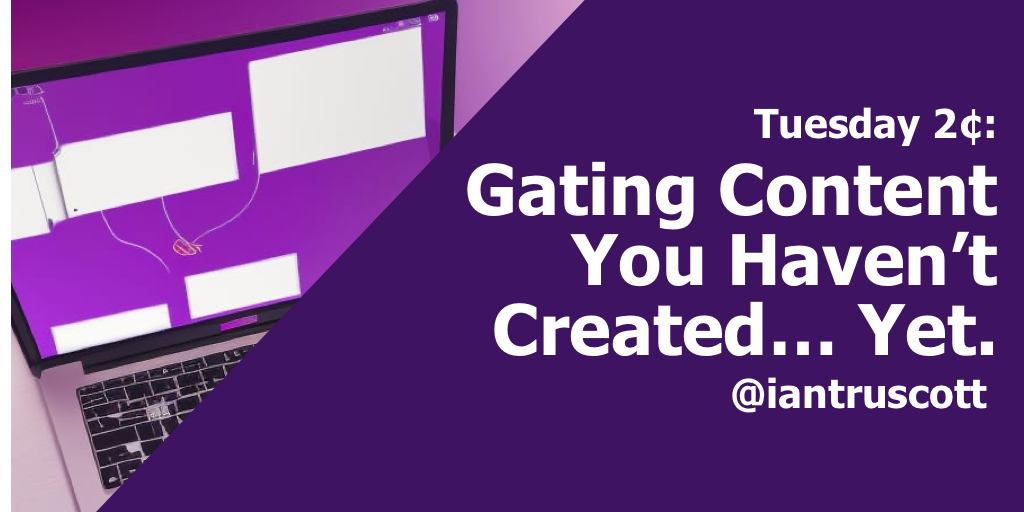Back on the topic of gating this week and the people that are interested in the content you have not created yet.
This week I am dipping back into the topic of gating content that I touched on a couple of weeks ago (in Gates and Thieves), and these 2 cents are partially stolen from inspired by my chum Robert Rose, and the wonderful podcast he does with Joe Pulizzi.
On their podcast a month or so ago, in their B2B special, Robert talked about the different motivations of someone filling in forms on your website, specifically the definition of a subscriber.
To roughly quote Robert – a subscriber is investing their email address and attention in the content you will produce, and they trust that not only is the piece of content that they are exchanging their email address for right now will be useful but so will the next piece of content and the next that your share.
These are the folks who get annoyed by Outlook and Google’s strategy to hide your newsletter. As they really want to read it, they seek it out. (Yeah, Google stop hiding Ann Handley’s newsletter).
But, thinking about this, in B2B marketing, do we want subscribers?
Let’s back up a bit. Someone who fills in a form on a website is probably one of these:
- Not interested in you or your product at all, just like this specific item of content for free
- Maybe interested in your product at some future point or not the buyer, doing some research to make the business case or understand if the category you are in can solve their problem
- Understand that your product can solve their problem, and this is a signal of intent to buy, yes please, contact me.
- See you as a thought leader and genuinely want to subscribe and consume your future content.
In B2B, we tend to think of everyone who fills in a form as someone who should be nurtured to buy (#2 or #3) or is a subscriber (#4), and treat them as such, that they are very interested in getting our emails.
Nobody in sales or marketing is interested in #1, obviously. The tricky thing with these folks is that the more valuable the content, the more of them you will get. The burner Gmail address crowd (or the thieving bastards in my last post), to whom you might as well have given this content for free to save cluttering your database.
Clearly, sales will be all over #2 and #3. These are the folks we intended to capture with this content and the reason we gate every f**king thing.
You could debate if there were any point in gating for #2, early-stage nurture, as if they are interested after having done their research, they would come back, especially if you made the research easy.
And then the crowd that knows you can solve their problem (#3) will fill in a high intent form, like “request a demo” not be downloading thought leadership, so should we be gating for them either…? hmmm…. No gating? Good lord.
So, we get to #4, the subscribers.
Unless you value your business on having an engaged audience, like a publisher, are these folks any more valuable than group #1 if your content strategy objective is to shift a product or service? Are they buyers?
Our #2’s and #3’s will buy something, #1’s and #4’s not so much.
Aren’t the #1’s and #4’s the students, competitors, tyre kickers and time wasters that sales warned you about?
Yes.
But #4 are also the folk that genuinely want to hear from you and give your database value, the customers, fans, analysts, and influencers who trust in the value of the content that you will create, but have not created yet.
The featured image was created with the help of Artificial Intelligence using NightCafe Creator.
Fancy more of this?
Subscribe to my Rockstar CMO Newsletter

I’m a 3xCMO, now a marketing strategy advisor and podcast host at Rockstar CMO. Although, I’m not a rock star, but a marketing leader, strategist, content marketer, columnist, speaker, industry watcher, and creator of ART (Awareness, Revenue, and Trust) for the companies I work with. But most of all, I am an enthusiastic tea drinker.
You can find me on LinkedIn, Twitter, or now Threads! – or listen to my weekly podcast at Rockstarcmo.com
The half-baked thoughts shared on this blog may not reflect those of my employer or clients, and if the topic of this article is interesting or you just want to say hello please get in touch.
